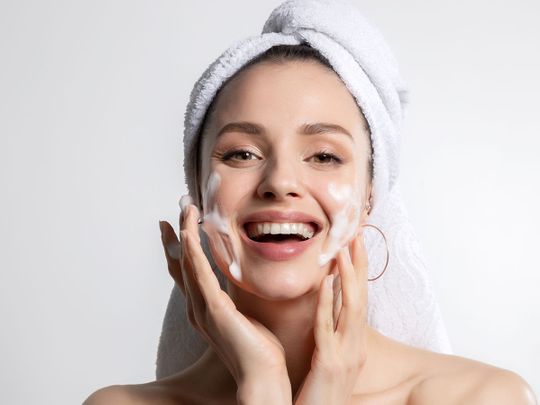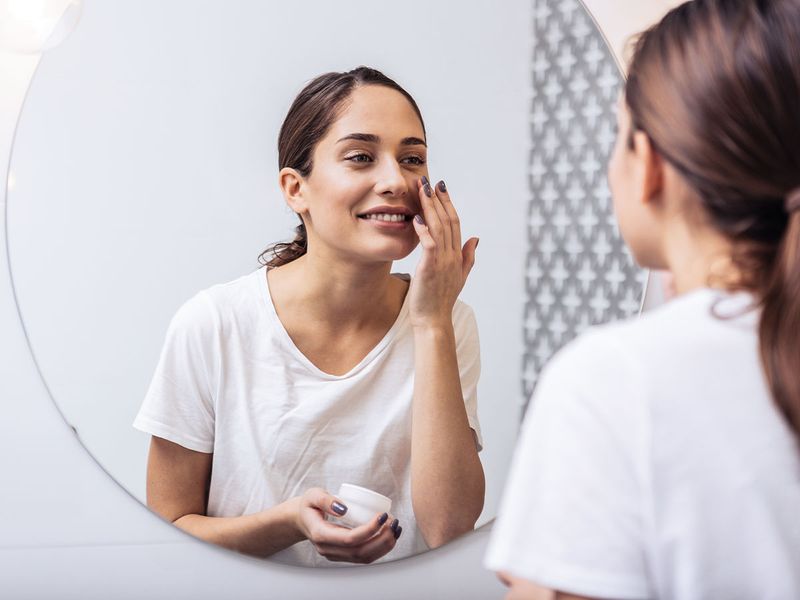
Where we would be without TikTok?
This time, the new skincare trend on the TikTok block is skin flooding. It sounds rather intense, but don’t worry; you’re not flooding your skin with anything to boost moisture.
Instead, this trend is all about locking water into your skin. It’s quite simple, and in fact, some of you might already be doing it without knowing it. It’s for everyone, especially for those who are rather worried about dryness and dehydration.
Let the experts show you how it’s done.
What is skin flooding?
As always, we can thank the Koreans for some inspiration.
“It’s a concept that dermatologists have been talking about for many years, and now it has emerged as a trend. The core of this concept is based on Korean skincare, where they use different kinds of materials for hydrating skin, and apply them in specific order,” explains Ghazli ilami, a Dubai-based dermatologist. According to the K-beauty multiple step method, you hydrate the skin as much as possible, by layering water-based serums or water-based toners.
Skin flooding also involves the layering of lightweight moisturising products to prevent dryness and dehydration. The star of this skincare show is usually hyaluronic acid as it grips the water molecules. "While dry and aging skin would benefit most from skin flooding, it’s a trend that anyone can benefit from, even oily and breakout-prone complexions," says Ilami.

How to go about it
Skin flooding is all about using and layering ingredients to optimally hydrate the skin, explains Lola Muhammad, aesthetician at Euromed Clinic in Dubai. Start with a gentle cleanse, and then leave the skin wet. Following this, you layer your products on damp skin, like essence and serums. Finally, seal all that hydration with moisture. Keep in mind that you need to start from thinnest to the thickest, so that the skin absorbs the moisture.

Skin flooding is a concept that dermatologists have been talking about for many years, and now it has emerged as a trend. The core of this concept is based on Korean skincare, where they use different kinds of materials for hydrating skin, and apply them in specific order...
“You apply serums that are humectants such as those with hyaluronic acid and finish the process with a heavier product such as a lotion or cream, which will trap the moisture into your skin,” she says.
Normally, you wait for a product to soak in, before applying the next one so that the ingredients are optimised. However, with skin flooding, the next ingredient is applied when the skin is still wet from the previous product’s application. This needs to be done, as when you apply products on moist skin, the active ingredients will be absorbed more effectively and efficiently. Your skin needs to be especially damp when applying your serum as it drags water into your skin and helps increase absorption.
“The skin will feel more nourished because the actives can penetrate the deeper layers of the skin more easily,” says Ridah Syed, senior medical aesthetician at the medical clinic, Skinfluencer London. If you have oily skin, it is recommended that you follow this routine regularly.
The process of layering with hyaluronic acid and niacinamide:

Start off a clean slate - get rid of any dirt or grime. Then, next step is when you introduce a humectant like hyaluronic acid. Hyaluronic acid can bind its weight in water, making it the ideal ingredient for skin flooding. Add a hydrating serum like niacinamide followed by a moisturiser.
Layering with Salicylic acid
Salicylic acid is known for fighting acne and spot treatment, and is derived from willow bark. It contains oil-soluble liquids that can penetrate the skin more easily, which means that it dissolves the skin debris, which clogs pores. Put two to three drops on your face and gently spread it on your face after cleansing. After this, you can apply hyaluronic acid as the unclogged pores will require proper hydration to keep the skin fresh. Finish off with a moisturiser at the end of your skincare routine.
Ceramide-infused products
Ceramides are crucial lipids that help maintain the integrity of the skin barrier and hold hydration. It is recommended to use a moisturiser infused with ceramides at the end of the routine as it can help restore the skin barrier and repair hydration.
Squalane
Squalane is an emollient, and is similar to the skin’s natural oil. Squalane is light, antibacterial, and is also safe for easily reactive and acne-prone skins. So you can cleanse, apply squalene-based products, and then trap it all in with a moisturiser and sunscreen. Squalane softens skin, prevents water evaporation, keeps the skin moist, and keeps the inflammation under check.

Skin flooding only works if you layer your hydrating ingredients correctly. This is because different types of products and ingredients improve skin hydration via different mechanisms. For instance, hyaluronic acid adds moisture to the skin often by drawing it from the surrounding environment, while ceramides seal in moisture and prevent evaporation from the skin.
What are the benefits of skin flooding?
The main idea behind skin flooding is to hydrate the skin, and even get that much-needed glow. This technique helps products in penetrating the skin, increasing their efficacy that can result in deeper and longer lasting hydration.
“This can be especially true for dry, dull skin at night, when flooding helps to restore lost moisture and ensure skin does not dry out too much,” she adds. The moisture is locked into all the layers of the skin, in order to retain water and keep the skin hydrated. This method can also help in preventing breakouts and dry skin, as the skin is drenched in moisture.
Layering hyaluronic acid with niacinamide, does have scientifically proven benefits, explains Muhammad. “Niacinamide is an antioxidant that hydrates and brightens the skin, as well as minimising oil production, while hyaluronic acid helps in hydrating the skin,” she says. Hyaluronic acid is a potent humectant, which makes it a powerhouse ingredient for skin, especially dry skin. When it is combined with niacinamides, it can support a healthy and hydrated skin barrier.
Bear in mind…

There aren’t too many downsides and issues with skin flooding as such, but you need to do your research and learn how to do it properly. Keep in mind, it only works if you layer your hydrating ingredients correctly, says Syed. “This is because different types of products and ingredients improve skin hydration,” she says.
“For instance, humectants such as hyaluronic acid add moisture to the skin often by drawing it from the surrounding environment, while emollients such as ceramides seal in moisture and prevent evaporation from the skin,” she explains. You need to layer the water-based products first, and then proceed to apply the heavier oil-based ones.
Moreover, do not layer potent ingredients such as exfoliating acids or retinol or put them directly on damp skin, warns Muhammed. “The moisture could speed up the rate at which they absorb into the skin and potentially cause irritation,” she says. On the other hand, those who are prone to acne outbreaks, be cautious about layering too many products as you can clog pores.
Never layer potent ingredients such as exfoliating acids or retinol or put them directly on damp skin. This is because the moisture could speed up the rate at which they absorb into the skin and potentially cause irritation.
It's advisable to do this just twice a week, says Ilami. "I suggest doing it only in your nighttime routine since flooding your skin during the day could leave you feeling sticky and weighed down from all the hydrating ingredients," she says."Plus, by doing it at night, you support your skin’s natural repair process and give it a boost of hydration to work with. And don’t feel like you need to do it every day—once or twice a week will do."
Is skin flooding safe for all skin types?
Skin flooding benefits various skin types, especially those that appear dull, dry, or dehydrated. Sensitive skin can benefit from increased moisture support, while oily skin can also partake in the practice, adjusting the frequency as needed. One should always tailor their skincare to the climate they are in as well, so people with oily skin can use this when visiting drier parts of the world," says Rumpa Singh, the head trainer of Urban Company's at-home salon service.
However, not all skin types can cope with layers of thick creams and lotions, especially oily skin, and acne-prone skin especially, says Syed. “Flooding offers an alternative because it primarily uses lightweight serums formulated with actives. Also, it’s worth noting that when skin is well-hydrated, it won’t compensate by producing oil, which can also clog pores,” she adds.









